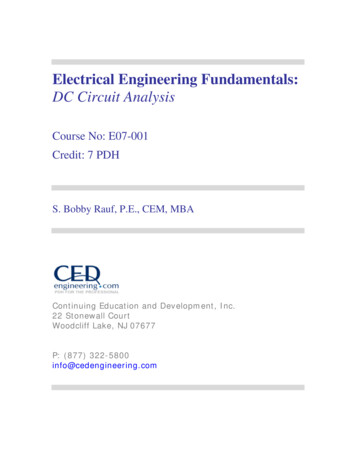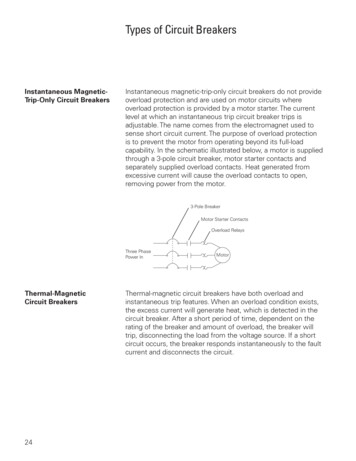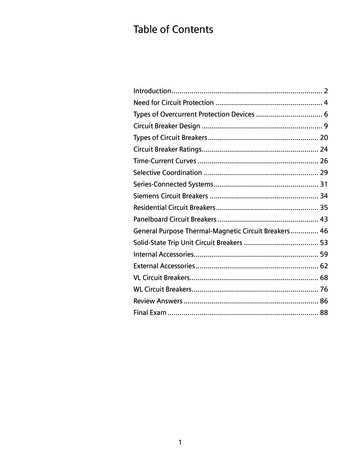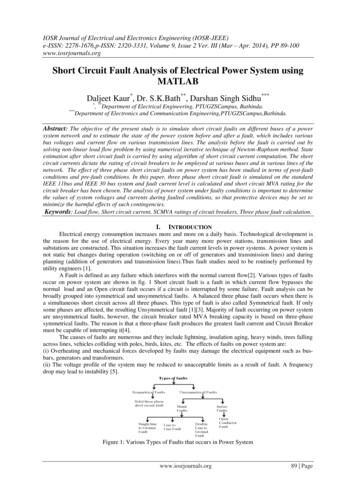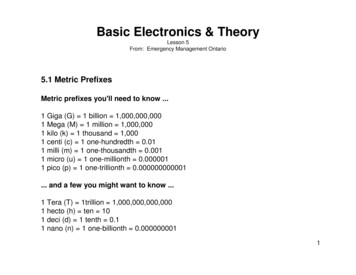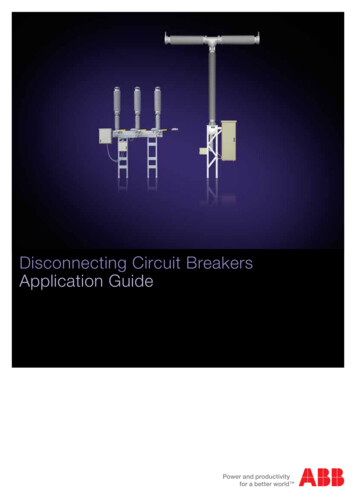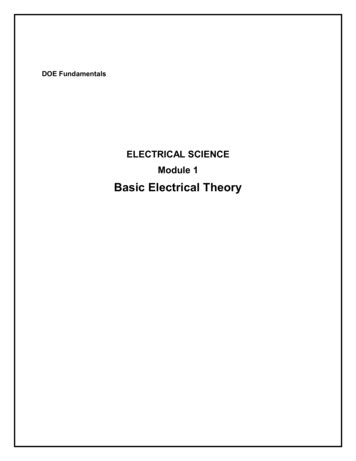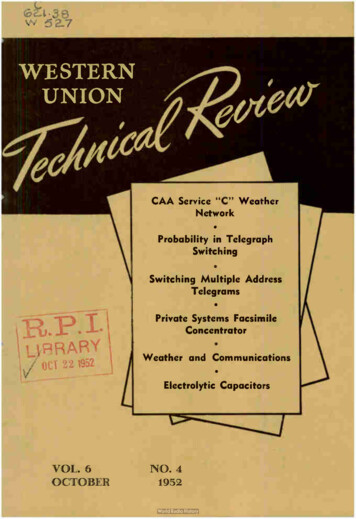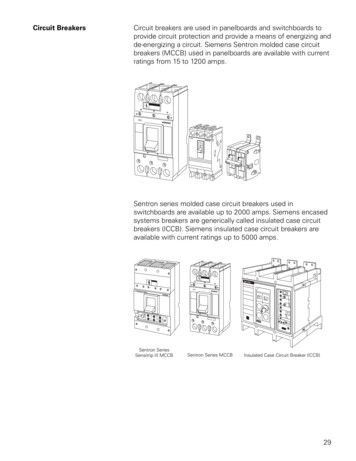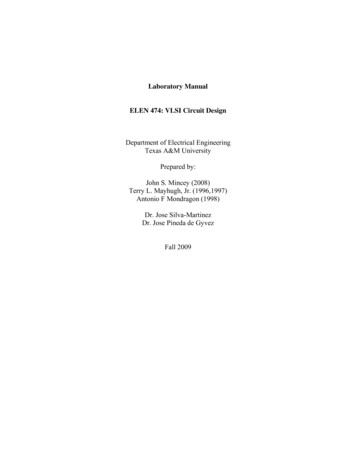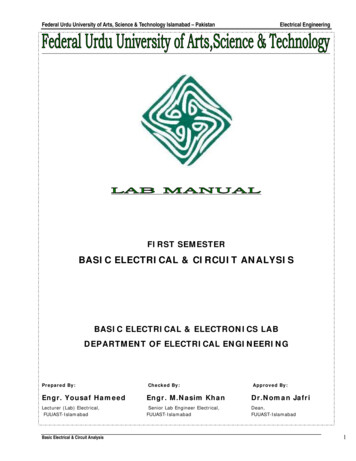
Transcription
Federal Urdu University of Arts, Science & Technology Islamabad – PakistanElectrical EngineeringFIRST SEMESTERBASIC ELECTRICAL & CIRCUIT ANALYSISBASIC ELECTRICAL & ELECTRONICS LABDEPARTMENT OF ELECTRICAL ENGINEERINGPrepared By:Checked By:Approved By:Engr. Yousaf HameedEngr. M.Nasim KhanDr.Noman JafriLecturer (Lab) Electrical,FUUAST-IslamabadSenior Lab Engineer sic Electrical & Circuit Analysis1
Federal Urdu University of Arts, Science & Technology Islamabad – PakistanElectrical EngineeringName:Registration No:Roll No:Semester:Batch:Basic Electrical & Circuit Analysis2
Federal Urdu University of Arts, Science & Technology Islamabad – PakistanElectrical EngineeringCCOONNTTEENNTTSSExp No12345List of ExperimentsFAMILIARIZATION WITH BASIC LAB EQUIPMENTMEASUREMENT OF RESISTANCE & CAPACITANCEVERIFICATION OF OHMS LAWCHARACTERISTICS OF SERIES DC CIRCUITCHARACTERISTICS OF PARALLEL DC CIRCUITS6SOFTWARE SIMULATION7MESH ANALYSIS8COMPUTER AIDED CIRCUIT ANALYSIS9SUPERPOSITION THEOREM10VERIFICATION OF THEVENIN'S THEOREM11MAXIMUM POWER TRANSFER THEOREM12AC RC CIRCUIT13AC RL CIRCUIT14A RLC CIRCUIT15POWER IN AC CIRCUITBasic Electrical & Circuit Analysis3
Federal Urdu University of Arts, Science & Technology Islamabad – PakistanElectrical EngineeringEXPERIMENT NO – 01FAMILIARIZATION WITH BASIC LAB EQUIPMENTOBJECTIVE:1. Familiarization with KL-100 Training System2. Familiarization with the use of Basic Lab Equipments Oscilloscope Function Signal Generator DC Power Supply Multi-MeterDISCRIPTION:KL – 100 Training System (Main Unit)Introduction and Operation of the top panelBasic Electrical & Circuit Analysis4
Federal Urdu University of Arts, Science & Technology Islamabad – PakistanElectrical EngineeringPower Supply:1. Dual DC Power Supply:Synchronous positive and negative voltageoutput. Turn the knob clockwise to increasevoltage and counterclockwise to decreaseOutput range: 3V 18V2. Fixed DC Power Supply: 4 preset outputs, 5, 123. AC Source:9V 0V 9VSignal Generator:4. Function Generator:Block 4 on figure listed from top downOUTPUT:50Ω 10% output impedance.FUNCTION:Waveform Selector (Triangle, Sine, Square)RANGE:100Hz 100KHz selector (4 ranges)AMPLITUDE:Amplitude controller, turn clockwise toincreaseFREQUENCY:Frequency controller, turn clockwise toincreaseMeasuring Instruments:5-a DC Voltmeter:0 20V5-b DC Amp meter:0 100mA 1A5-c AC Voltmeter:0 15V5-d AC Amp meter:0 100mA 1AThe tiny holes below these four meters are for fine adjustment.6. Digital DC Voltmeter/Amp meter:The volt/amp meter selector is on the bottomand the range selectors are on the left.CAUTION:This is a 3-1/2 digit LED display. When theincoming voltage or current exceeds itslimitation, a flashing "1" will be displayed. Ifthis happens, reduce the input immediately.When 2000mA is selected and the inputexceeds it, the internal fuse will be burned. A2A fuse is included in the accessory pack forreplacement purpose.Input/output Devices7. Speaker:8-a8-b8-c8-dan 8 Ω/0.25W speaker with driver circuit.1K Ω, 0.25W potential meter, with A, B, C terminal10 K Ω, 0.25W potential meters, with A, B, C terminal100K Ω, 0.25W potential meter, with A, B, C terminal1M Ω, 0.25W potential meter, with A, B, C terminal9. External Connection:Basic Electrical & Circuit AnalysisTwo 840 tie-point breadboard for circuitPrototyping and designing5
Federal Urdu University of Arts, Science & Technology Islamabad – PakistanElectrical Engineering10. Four modules mounting for securing the modules.Dual Trace Oscilloscope 20MHz (GW INSTEK GOS-620)Basic Electrical & Circuit Analysis6
Federal Urdu University of Arts, Science & Technology Islamabad – PakistanBasic Electrical & Circuit AnalysisElectrical Engineering7
Federal Urdu University of Arts, Science & Technology Islamabad – PakistanBasic Electrical & Circuit AnalysisElectrical Engineering8
Federal Urdu University of Arts, Science & Technology Islamabad – PakistanElectrical EngineeringEXPERIMENT NO – 02MEASUREMENT OF RESISTANCE & CAPACITANCEOBJECTIVE:Introduction to the Measuring Methods of Resistance and CapacitanceEQUIPMENT/COMPONENTS REQUIRED:1. Different Valued Resistors, Capacitors2. VOM (Volt-Ohm-Milliammeter)3. DMM (Digital Multimeter)THEORY & PROCEDURE:NOTE:The purpose of this experiment is to acquaint you with the equipment, so do not rush.Learn how to read the meter scales accurately, and take your data carefully. You mustbecome comfortable with the instruments if you expect to perform your future job function in aprofessional manner.“Part 1: Resistance Measurement”METHOD 1: Resistance Measurement using VOM/ DMM:1. Resistance is never measured by an ohm-meter in a live network, due to the possibilityof damaging the meter with excessively high currents and obtaining readings that haveno meaning.2. Always start with the highest range of the instrument and switch down to the properrange successively.3. Use the range in which the deflection falls in the upper half of the meter scale.4. Try to ascertain the polarity of dc voltages before making the measurement.5. Whenever measuring the resistance of a resistor in a circuit, note whether there areany other resistive elements that could cause an error in the reading. It may benecessary to disconnect one side of the resistor before measuring.6. Check the zero and ohms adjustments each time the range is changed.7. When making measurements, grip the test prods by the handles as close to the leadend as possible. Do not allow the fingers to touch the prod tips while measuring.8. Keep the instruments away from the edge of the workbench, and away from heat anddangerous fumes.Basic Electrical & Circuit Analysis9
Federal Urdu University of Arts, Science & Technology Islamabad – PakistanElectrical Engineering9. There is no zero adjustment on a DMM, but make sure that R 0 ohm when the leadsare touching or an adjustment internal to the meter may have to be made. Anyresistance above the maximum for a chosen scale will result in an O.L. indication.10. The ranges are usually marked as multiples of R. For example,R x 1, R x 10, R x 100, R x 1 kThe value of the resistor can be found by multiplying the reading by the range setting.For example, a reading of 11 on the R x 1 kΩ range is 11 x 1 kΩ 11 k Ω, or 11, 000 Ω.METHOD 2: Resistance Measuring Using Color Coding:1. The resistance of many resistors can be determined by reading a series of coloredbands imprinted on the resistor body. In this scheme called “Resistor Color Code” eachcolour represents a different decimal digit, as shown in fig. 1 and Table 2.Table 2: Resistor Color Code:The first three bands of the color code are used to specify nominal value of the resistance, andthe fourth, or tolerance band, gives the percent deviation from the nominal value that the actualresistor may have. Due to manufacturing variations, the actual resistance may be anywhere in arange equal to the nominal value plus or minus a certain percentage of that value.Basic Electrical & Circuit Analysis10
Federal Urdu University of Arts, Science & Technology Islamabad – PakistanElectrical EngineeringFigure – 1Basic Electrical & Circuit Analysis11
Federal Urdu University of Arts, Science & Technology Islamabad – PakistanElectrical EngineeringCapacitor Colour CodeA colour code was used on polyester capacitors for many years. It is now obsolete, butof course there are many still around. The colours should be read like the resistor code, thetop three colour bands giving the value in pF. Ignore the 4th band (tolerance) and 5th band(voltage rating).For example: brown, black, orange means10000pF 10nF 0.01µF.Note that there are no gaps between the colours bands, so 2 identical bands actuallyappear as a wide band.For example: wide red, yellow means 220nF 0.22µF.NUMERICAL CODESNumerical Codes are used with non - electrolytic capacitors to specify theircapacitance. Usually, these codes are 3 digit long, specifying the capacitance in Pico Farads;the first two digits are Tens and Units, where as the third digit is power of 10.Basic Electrical & Circuit Analysis12
Federal Urdu University of Arts, Science & Technology Islamabad – PakistanElectrical EngineeringFor example: 102 means 1000pF 1nF (not 102pF!)For example: 472J means 4700pF 4.7nF (J means 5% tolerance).For example: 333K means 33000pF 33nF (K means 10% tolerance).Figure – 2: CapacitorsBasic Electrical & Circuit Analysis13
Federal Urdu University of Arts, Science & Technology Islamabad – PakistanElectrical Engineering2.The first two color bands specify the first two digits of the nominal value, and the thirdband represents the power of 10 by which the first two digits are multiplied.3- The example below demonstrates these computations.Solution:-Thus,Nominal resistance 47 x 103 Ω 47k ΩThe possible range of actual values is:47 k Ω (0.1) 47 k Ω 47kΩ 4.7k ΩOr From 42.3 kΩ to 51.7 k Ω“Part 2: Capacitance Measurement:”CAPACITOR:There are two types of capacitors, i.e. electrolyte and non - electrolyte capacitors. Thenon-electrolytic capacitors use Paper, Mica, Ceramic, Mylar, Glass, Porcelain, Polycarbonate,and Wax as Insulator. Figure 2 shows symbols of the two types of the capacitor. Thedifference in the use of the two types of capacitors is that non-electrolytic capacitors can becharged in any direction, where as the Electrolytic ones can only be charged in one direction.Electrolytic Capacitors are Polar; i.e., one of its two plates is Positive and other is Negative,whereas in non-electrolytic capacitors, both the plates are same, having no polarity.Basic Electrical & Circuit Analysis14
Federal Urdu University of Arts, Science & Technology Islamabad – PakistanElectrical EngineeringOBSERVATION:TABLE –AResistorsColour Bands1 2 3 4Red, Red, Black, GoldExampleColour Bands1 2 3 42 2 0 5 inimumResistances20.9Ω12345TABLE - BResistorExampleMeasured Value(VOM / DMM)23ΩFalls within specifiedtoleranceYes12345Basic Electrical & Circuit Analysis15
Federal Urdu University of Arts, Science & Technology Islamabad – PakistanElectrical EngineeringEXPERIMENT NO: 03VERIFICATION OF OHMS LAWOBJECTIVE:To Verify Ohms Law for a series resistive NetworkEQUIPMENT/COMPONENTS REQUIRED:1. DC Power Supply2. Multi-meter3. Bread Board4. ResistorsTHEORY:Ohms Law simply states that:"The current is inversely proportional to the Resistance. The Ohms law can becombined mathematically to give the expression as I V/R.The Ohms law correctly expresses the relationship as for a fixed resistance, current increases whenvoltage increases, and for a fixed voltage, Current decreases when Resistance increases.FIGURE:Circuit Diagram for Ohms Law VerificationBasic Electrical & Circuit Analysis16
Federal Urdu University of Arts, Science & Technology Islamabad – PakistanElectrical EngineeringPROCEDURE:1. Construct the circuit as shown in figure.2. Apply power to the circuit and by varying R1 measure and record the voltage drop across R2in the Table3. Now, break the circuit at the input and place ammeter and measure the current flowing throughthe circuit and record in the table.4. By measuring the voltage drop across , and the current through , the resistive circuit verify theOhms law with the equation (I V/R)TABLE:VsITR1R2VRESULTS:Basic Electrical & Circuit Analysis17
Federal Urdu University of Arts, Science & Technology Islamabad – PakistanElectrical EngineeringEXPERIMENT NO - 04CHARACTERISTICS OF SERIES DC CIRCUITOBJECTIVE:To investigate the characteristics of a series DC circuitEQUIPMENT/COMPONENTS REQUIRED:1. DMM2. DC Supply3. Resistors of 220Ω(RR Br), 330Ω(Or Or Br) & 430Ω(Y, Or, Br).THEORY:In a series circuit, (Fig 4.1), the current is the same through all of the circuit elements.The total Resistance RT R1 R2 R3.By Ohm’s Law, the Current “I” isApplying Kirchoff’s Voltage Law around closed loop of Fig 4.1, we find.Where,Note in Fig 4.1, that I is the same throughout the Circuit.The voltage divider rule states that the voltage across an element or across a seriescombination of elements in a series circuit is equal to the resistance of the element divided bytotal resistance of the series circuit and multiplied by the total imp4ressed voltage. For theelements of Fig 4.1Basic Electrical & Circuit Analysis18
Federal Urdu University of Arts, Science & Technology Islamabad – PakistanElectrical EngineeringFigure – 4.1Figure – 4.2PROCEDURE:1. Construct the circuit shown in Fig 4.2.2. Set the Dc supply to 12V by using DMM. Pick the resistances having values 220Ω, 330Ω&430Ω. Also verify their resistance by using DMM.3. Measure voltage across each resistor with DMM and record it in the Table (b).4. Measure Current I delivered by source.5. Shut down and disconnect the power supply. Then measure input resistance RT across pointsA-E using DMM. Record that value.) and6. Now Calculate, respective currents (using7. Calculate V1 & V2 using voltage divider rule and measured resistance value.8. Create an open circuit by removing R3& measure all voltages and current I.Note: Use measured value of resistance for all calculations.Basic Electrical & Circuit Analysis19
Federal Urdu University of Arts, Science & Technology Islamabad – PakistanElectrical EngineeringOBSERVATIONS:a. ResistorsS.NoNominal Values(Ω)1R1 220 Ω2R2 220 Ω3R3 330 Ω4R4 430 ΩMeasured Values(Ω)RT (Measured)(Ω)RT (Calculated)(Ω)b. VoltagesS.NoMeasured Value(V)Calculated Value (V)(VDR)Measured ValuesWhen R3 is Open Circuited(V)1234C. CurrentS.NoCalculated Value (A)Ohms LawMeasured Value of I(A)Measured Value of IWhen R3 is Open Circuited(A)1234Basic Electrical & Circuit Analysis20
Federal Urdu University of Arts, Science & Technology Islamabad – PakistanElectrical EngineeringEXPERIMENT NO - 05CHARACTERISTICS OF PARALLEL DC CIRCUITSOBJECTIVE:To Investigate the characteristics of parallel dc circuitsEQUIPMENT/COMPONENTS REQUIRED:1. 15V DC Power Supply.2. DMM.3. 2x 1KΩ (Br, Black, Red).4. 2KΩ(R, Black, Red).THEORY:In a parallel circuit (Fig 5.1) the voltage across parallel elements is the same.The total or equivalent resistance (RT) is given by.If there are only two resistors in parallel, it is more convenient to use.In any case, the total resistance will always be less than the resistance of the smallestresistor of the parallel network. For the network of Fig 5.1. The currents are related by thefollowing expression.Applying current divider rule (CDR) & the network of Fig 5.2AndFigure – 5.1Basic Electrical & Circuit Analysis21
Federal Urdu University of Arts, Science & Technology Islamabad – PakistanElectrical EngineeringFigure – 5.2Figure – 5.3For equal parallel resistors, the current divides equally and the total resistance is the value ofone divided by the ‘N’ number of equal parallel resistors, i.e.For a parallel combination of N resistors, the current IK through RK is.Basic Electrical & Circuit Analysis22
Federal Urdu University of Arts, Science & Technology Islamabad – PakistanElectrical EngineeringPROCEDURE:1. Construct the circuit shown in Fig 5.3.2. Set the DC supply to 15V by using DMM. Pick the resistances values 1KΩ, 1KΩ, and 2KΩ.Also verify their resistance by using DMM.3. Measure voltage across each resistor with DMM and record it in the Table b.4. Measure the currents IT, I1, I2, and I3.5. Shut down & disconnect the power supply. Then measure input resistance ‘RT’ across pointsA-B using DMM. Record that value.6. Now calculate respective voltages (using V IR) and RT (using equivalent resistance formula).7. Calculate I1, I2 , I3 using CDR.8. Create an open circuit by removing R2 and measure all voltages and currents.Note: Use measured value of resistance for all calculations.OBSERVATION:a) Resistors:S.NoNominal Values(Ω)1R1 1K2R2 1K3R3 2KMeasured Value(Ω)RT Measured(Ω)RT Calculated(Ω)b) Voltages:S.NoMeasured Values(V)Calculated Value(Ohms Law) (V)Measured Values when R2 isOpen Circuited (V)1V1 V1 V1 2V2 V2 V2 3V3 V3 V3 Basic Electrical & Circuit Analysis23
Federal Urdu University of Arts, Science & Technology Islamabad – PakistanElectrical EngineeringC) Current:S.NoMeasured Values(A)Calculated Value(CDR) (A)Measured Values when R2 isOpen Circuited (A)1I1 I1 I1 2I2 I2 I2 3I3 I3 I3 4IT IT IT Basic Electrical & Circuit Analysis24
Federal Urdu University of Arts, Science & Technology Islamabad – PakistanElectrical EngineeringEXPERIMENT NO - 06SOFTWARE SIMULATIONVerify Experiment 3 (Ohms Law), Experiment 4 (KVL) & Experiment 5 (KCL) by the use ofProteus / Electronic Workbench also Submit a printout of a proper labeled schematic. Include handcalculation.Use all values of resistances, voltages and currents of Experiment No: 3, 4 & 5.Circuit Diagram for Ohms LawCircuit Diagram for KVLCircuit Diagram for KCLBasic Electrical & Circuit Analysis25
Federal Urdu University of Arts, Science & Technology Islamabad – PakistanElectrical EngineeringEXPERIMENT NO - 07MESH ANALYSISOBJECTIVE:To analyze a two Mesh circuit and to determine the current in each branch of the circuitEQUIPMENT/COMPONENTS REQUIRED:1. DC Power Supply2. Multi-meter3. Bread Board4. ResistorsTHEORY:Algebraic sum of voltages around a close loop is zero.Applying KVL to mesh 1- E1 I1R1 (I1 - I2) R2 0I1 (R1 R2) - I2R2 E1(1)Applying KVL to mesh 2- E2 (I2 - I1) R2 I2R3 0I2 (R2 R3) - I1R2 E2R1 R2-R2(2)I1E1 -R2Basic Electrical & Circuit AnalysisR2 R3I2E226
Federal Urdu University of Arts, Science & Technology Islamabad – PakistanElectrical EngineeringCALCULATION:Basic Electrical & Circuit Analysis27
Federal Urdu University of Arts, Science & Technology Islamabad – PakistanElectrical EngineeringFIGURE:FigurePROCEDURE:1. Construct the circuit shown in Fig2. Set the DC supply E1 12V and E2 5V.3. Pick the resistances. Also verify their resistance by meter and record it in table.4. Measure the currents through resistances R1, R2 & R3 and record it in table.5. Now Set the DC supply E1 5V and E2 12V.6. Repeat step 4 & 5 and record all the valuesNote: Use measured value for all calculations.TABLE:E1E212v5v5v12vBasic Electrical & Circuit AnalysisR1R2R3I1I2IR2VR1VR2VR328
Federal Urdu University of Arts, Science & Technology Islamabad – PakistanElectrical EngineeringEXPERIMENT NO - 08COMPUTER AIDED CIRCUIT ANALYSISUse Proteus / Electronic Work Bench to verify the solution of givenquestions also Submit a printout of a proper labeled schematic. Include handcalculation1-Determine the voltage across the 2-mA source. Assuming the bottom node isground.2-Use mesh analysis to find ix in the circuit shown.Basic Electrical & Circuit Analysis29
Federal Urdu University of Arts, Science & Technology Islamabad – Pakistan3-Electrical EngineeringUse the mesh concept to determine the power supplied by the 2.2-V source.Basic Electrical & Circuit Analysis30
Federal Urdu University of Arts, Science & Technology Islamabad – PakistanElectrical EngineeringEXPERIMENT NO: 09SUPERPOSITION THEOREMOBJECTIVE:To Verify Superposition Principle in DC CircuitsREQUIRED:123-DMM2 DC Power Supplies,Resistances (1k Ω, 2k Ω, 430k Ω)THEORY:The superposition principle states that:“The current through or voltage across, any resistive branch of amultisource network is the algebraic sum of the contribution due to eachsource acting independently.”When the effect of one source is considered, the others are replaced by their internalresistances. This principle permits one to analyze circuits without restoring to simultaneousequations.Superposition is effective only for linear circuit relationship. Non-linear effects, such as power,which varies as the square of the current or voltage, cannot be analyzed using this principle.FIGURE:Fig-1Basic Electrical & Circuit Analysis31
Federal Urdu University of Arts, Science & Technology Islamabad – PakistanElectrical EngineeringFig – 2Fig – 3PROCEDURE:1. Construct the Network of Fig-1, where R1 1 k Ω, R2 430 Ω, R3 2 k Ω. Verify theresistances using DMM.2. Using superposition and measured resistance values, calculate the currents indicatedin observation Table (a), for the network of Fig-1. Next to each magnitude include asmall arrow to indicate the current direction for each source and for the completenetwork.3. Energize the network of Fig-1 and measure the voltages indicated in observation tableb, calculate current in Table (b) using Ohm’s Law. Indicate the polarity of the voltagesand direction of currents on Fig-1.4. Construct the network of Fig -2. Note that source E2 has been removed.5. Energize the network of Fig -2 and measure the voltages indicated in Table (c).Calculate currents using Ohm’s Law.6. Now construct the network of Fig -3. Note that source E1 has been removed.7. Energize the network of Fig -3 and measure the voltages indicated in Table (d).Calculate currents using Ohm’s Law.8. Using the results of steps # 3, 5 and 7, determine the power delivered to each resistorand insert in Table (e).Basic Electrical & Circuit Analysis32
Federal Urdu University of Arts, Science & Technology Islamabad – PakistanElectrical EngineeringOBSERVATIONS:Resistors:Nominal Values (Ω)11K243032KMeasured Values (Ω)a) Calculated Values for the Network of Fig. 6.1Due to E1Due to E2Algebraic Sum ( )I1 I1 I1 I2 I2 I2 I3 I3 I3 b) Measured Values for the Network of Fig. 6.1V1c)V2V3I1I2I3Measured Values for the Network of Fig. 6.2V1V2V3I1I2I3d) Measured Values for the Network of Fig. 6.3V1V2V3I1I2I3e) Power Absorbed ( use measured values of I and V)Due to E1Basic Electrical & Circuit AnalysisDue to E2Sum of Columns 1 & 2E1 & E2 ActingSimultaneously33
Federal Urdu University of Arts, Science & Technology Islamabad – PakistanElectrical EngineeringEXPERIMENT NO: 10VERIFICATION OF THEVENIN'S THEOREMOBJECTIVE:To Verify Thevenin Theorem by finding its Thevenin’s Equivalent CircuitREQUIRED:1. VOM/DMM2. Power Supply3. Resistances (120Ω, 1k Ω, 390Ω)THEORY:Any linear circuit is equivalent to a single voltage source (Thevenin's Voltage) in serieswith single equivalent resistance (Thevenin’s Equivalent Resistances)The current flowing through a load resistance RL connected across any two terminalsA and B of a network is givenFIGURE:Fig – 1Fig – 2Basic Electrical & Circuit Analysis34
Federal Urdu University of Arts, Science & Technology Islamabad – PakistanElectrical EngineeringFig – 3PROCEDURE:1. Reduce the circuit by calculating the Thevnin equivalent resistance across the terminals A & B2. Determine the Thevinin equivalent voltage across terminals “A” and “B” for 5V, 10V, 15V.3. Now, combine the Thevenin voltage with its resistance determines across 120Ω, 1K Ω, and390 Ω VTHRTHRLIL1205V3901K12010V3901K12015V3901KBasic Electrical & Circuit Analysis35
Federal Urdu University of Arts, Science & Technology Islamabad – PakistanElectrical EngineeringEXPERIMENT NO: 11VERIFICATION OF MAXIMUM POWER TTRANSFER THEOREMOBJECTIVE:To Verify Maximum Power Transfer TheoremDiscussionMaximum power transfer theorem states that any linear network, if the load resistance equals itsThevenin’s equivalent resistance, the load can yield a maximum power from sources.Now we consider the Thevenin’s equivalent shown in Fig 1. By Ohm’s Law, the power dissipated in the LoadPRL can be expressed as follows.I ETH / (RTH RL)PRL I2*RLPRL [ETH / (ETH RL)2*RLorPRL (ETH2*RL) / (RTH RL)2Figure-1Suppose ETH 4V and RTH 5Ω, then PRL can be expressed by the equation PRL 16 RL / (5 RL)2. Nowwe calculate and record each of the PRL values for each RL value from 1 Ω to 9 Ω increasing the step to 1 Ω. Theresults are listed in Table 1 and plotted in Fig 2. From both Table 1 and fig- 2, you can find that the maximumvalue of PRL occurs at RL RTH.Basic Electrical & Circuit Analysis36
Federal Urdu University of Arts, Science & Technology Islamabad – PakistanElectrical EngineeringTable – 1Figure -2Procedure1.2.3.4.Set the Module KL-13001 on the main KL-21001, and locate the block a.According to Figs. 1 , complete the experiment circuit with short-circuit clips.Apply 15V to V.Turn off the power switch.Adjust VR1 to 250 Ω. (Let R1 RTH, VR1 Rl).Turn on the power.Measure and record the current flowing through VR1 as indicated by the milliammter.I mA.Calculate and record the power dissipated by VR1 using the equationPRL I2*RL. PRL W.Turn off the power.5.6.7.8.Adjust VR1 to 500 Ω and repeat step 4.I mAPRL WAdjust VR1 to 1 K Ω and repeat step 4.I mAPRL WAdjust VR1 to 1.25 K Ω and repeat step 4.I mAPRL WAdjust VR1 to 1.5 K Ω and repeat step 4.I mAPRL W9.Complete Fig. 4 by using you measured I and calculated PRL values.Basic Electrical & Circuit Analysis37
Federal Urdu University of Arts, Science & Technology Islamabad – PakistanElectrical EngineeringEXPERIMENT NO: 12AC RC CircuitOBJECTIVE:To understand the characteristics of an RC series network in ac circuitDiscussionWhen an ac voltage is applied across a pure resistance, the resultant current is in phase with the applied voltage.Resistance therefore has no phase angle associated with it and is written as R 0. When an ac voltage is appliedacross a pure capacitor, the resultant current leads the voltage by 90. Capacitance therefore has a phase angleassociated with it. The opposition that a capacitor offers to the flow of alternating current is called capacitivereactance and is written as Xc-90, or –jXc. The magnitude of Xc is Xc 1/2π fC 1/wC.An RC series circuit with an ac supply voltage is shown Fig . The impedance of this circuit can be expressed asZT Z1 Z2 R 0 XC -90The current in the across R isER I RThe voltage across C isBy Kirchhoff’s voltage law, thenEC I XCΣV E-VR-VC 0Or FigureBasic Electrical & Circuit Analysis38
Federal Urdu University of Arts, Science & Technology Islamabad – PakistanElectrical EngineeringProcedure1. Set the module KL-13001 on the main unit KL-21001, and locate the block e.2. According to Figs. 1 complete the experiment circuit with short-circuit clips. Apply the AC power 9V to EA.Measure and record EA V3. Calculated and record the values below.Reactance of C2XC ΩTotal impedanceZT ΩCurrent in circuitI mAVoltage across R8R VVoltage across C2EC VPower dissipatedP mW4. Measure and record the values of ER and EC by using the ac voltmeter.Voltage across R8R VVoltage across C2EC VAre you sure the measured values equal to the calculated values of step 3?YesNO 4. Using the equationEA , calculate the applied voltage of the circuit.VDoes the calculated value equal the measured value of step 2?YesNOIf no, explain it.5. Using the measured values of ER and EC, calculate and record the current I.I mADoes the calculated value equal the measured value of step 3?YESNO6. Using the values of R, XC and ZT, plot a vector diagram in space below.Basic Electrical & Circuit Analysis39
Federal Urdu University of Arts, Science & Technology Islamabad – PakistanElectrical EngineeringEXPERIMENT NO: 13AC RL CircuitOBJECTIVE:To understand the characteristics of an RL series network in ac circuitDiscussionWhen an ac voltage is applied across a pure inductance, the current lags the voltage by 90.Inductance therefore has phase angle associated with it .The opposition that an inductance offers to theflow of alternating current is called inductive reactance and may be expressed asjThe magnitude of.is, or 2πfL 2 LAn RL series circuit with an ac supply voltage is shown in Fig-1.The impedance of this circuit can beexpressed asThe current in the circuit isL E/The voltage across R is l RThe voltage across l is IBy Kirchhoff s voltage law, thenV E -(the current lags the voltage)- 0FigureBasic Electrical & Circuit Analysis40
Federal Urdu University of Arts, Science & Technology Islamabad – PakistanElectrical EngineeringProcedure1. Set the module KL -13001 on the main unit KL-21001, and locate the block f, link 0.5Hinductance at L1 position.2. According to Figure complete the experiment circuit with short –circuit clips. Apply the ACpower 9V to EA.Measure and record EA.EA V3. Calculate and record the values below.Reactance of L1 ΩTotal impedance ΩCurrent in circuitI mAVoltage across R9 VVoltage across L1 VPhase anglePower dissipated P mW and4. Measure and record the values of by Using the AC voltmeter.Voltage across R9 VVoltage across L1 V5. Do the measured values equal the calculated values of step 3?YesNo, calculate the applied voltage of the circuit6. Using the equationEA VDoes the calculated value equal the measured value of step 2?YesNoIf No explain it.Basic Electrical & Circuit Analysis41
Federal Urdu University of Arts, Science & Technology Islamabad – PakistanElectrical EngineeringEXPERIMENT NO: 14AC RLC CircuitOBJECTIVE:To understand the characteristics of an RLC series network in ac circuitDiscussion:Figure shows an RLC series-parallel circuit with an ac power supply as mentionedbefore. The capacitive reactanceand inductive reactancevery with frequency.Therefore, the net impedance of the parallel circuit consisting of l2 and C3 will vary with inputfrequency. At some frequency which we will define as the resonant frequencycircuit operates in resonance andequals.the parallelthe resonant frequency can be expressed asFigureProcedure1. Set the module KL -13001 on the main unit KL -21001, and locate the block h.2. According to Figure, complete the experiment circuit with short –circuit clips.The L2 is the 0.1H inductor provided.3. Set the function selector of function generator to sine wave position .connect the oscilloscopeto the output of function g
Basic Electrical & Circuit Analysis 17 PROCEDURE: 1. Construct the circuit as shown in figure. 2. Apply power to the circuit and by varying R1 measure and record the voltage drop across R2 in the Table 3. Now, break the circuit at the input and place ammeter and measure the current flowing through the circuit and record in the table. 4.
